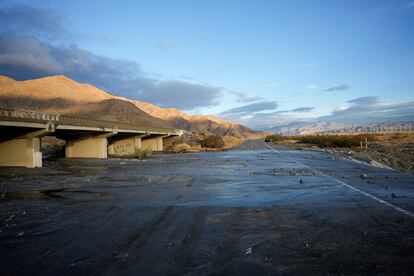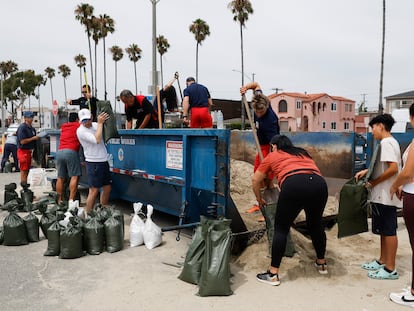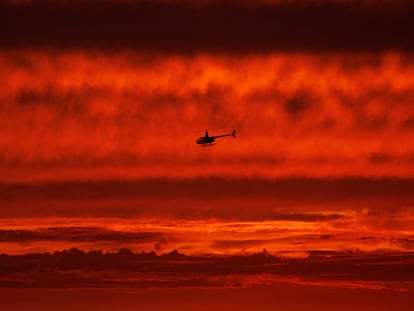Post-Tropical Storm Hilary pushes into Nevada after drenching Southern California
The National Hurricane Center in Miami downgraded Hilary to a post-tropical storm Monday, but warned that ‘continued life-threatening and locally catastrophic flooding’ was expected over portions of the southwestern U.S.

Tropical Storm Hilary drenched Southern California from the coast to the desert resort city of Palm Springs, forcing rescuers to pull several people from swollen rivers, before heading east and flooding a county about 40 miles (64 kilometers) outside of Las Vegas.
The National Hurricane Center in Miami downgraded Hilary to a post-tropical storm Monday morning, but warned that “continued life-threatening and locally catastrophic flooding” was expected over portions of the southwestern U.S., along with “record-breaking” rainfall and potential flooding in states as far north as Oregon and Idaho.
Remnants of the storm that first brought soaking rains to Mexico’s arid Baja California Peninsula and the border city of Tijuana were expected to linger at least through Tuesday morning.
Southern Californians were battling flooded roads, mudslides and downed trees. Winding roads in the San Bernardino Mountains east of Los Angeles were blocked by mud and debris flows. A stretch of the I-10 freeway near Palm Springs was also shut to traffic due to pooling water from the storm.
Along the coast, a stretch of the Pacific Coast Highway in surf-friendly Huntington Beach was also flooded.
“Thank God, my family is OK,” Maura Taura said after a three-story-tall tree crashed down on her daughter’s two cars but missed the family’s house in the Sun Valley area of Los Angeles.
Hilary is just the latest major weather or climate disaster to wreak havoc across the U.S., Canada and Mexico. Hawaii’s island of Maui is still reeling from a blaze that killed more than 100 people and ravaged the historic town of Lahaina, making it the deadliest U.S. wildfire in more than a century. Firefighters in Canada are battling that nation’s worst fire season on record.
The first tropical storm to hit Southern California in 84 years, Hilary first made landfall in Baja California on Sunday in a sparsely populated area about 150 miles (250 kilometers) south of Ensenada. One person drowned. It then moved through mudslide-prone Tijuana, threatening the improvised homes that cling to hillsides just south of the U.S. border.
Hilary dropped more than half an average year’s worth of rain on some areas, including Palm Springs, which saw more than 3 inches (8 centimeters) of rain by Sunday evening.
Forecasters warned of dangerous flash floods across Los Angeles and Ventura Counties, and fire officials rescued 13 people from knee-deep water in a homeless encampment along the rising San Diego River. Meanwhile, rain and debris washed out some roadways and people left their cars stranded in standing water. Crews pumped floodwaters out of the emergency room at Eisenhower Medical Center in Rancho Mirage.
Sunday was the wettest day on record in San Diego, with 1.82 inches (4.6 centimeters), the NWS said in a post on X, formerly known as Twitter. The previous record was on Aug. 17, 1977, when 1.8 inches (4.5 centimeters) of rain fell in the area post-Hurricane Doreen.
“We basically blew all of our previous rainfall records out of the water,” National Weather Service meteorologist Elizabeth Adams in San Diego told The Associated Press. In Palm Springs, the inundation shattered the daily record of 0.21 inches set in 2003 with 3.18 inches falling Sunday.
The center of Hilary passed over downtown Los Angeles at 7 p.m. Sunday, according to the regional weather office, which called it “a day for the ages” in Southern California.
Despite the deluge, Los Angeles Fire Chief Kristin Crowley said no significant injuries or damages were reported.
City Council President Paul Krekorian told a news conference that “Los Angeles was tested, but we came through it, and we came through it with minimal impacts considering what we endured.”
The Los Angeles Unified School District, the nation’s second-largest school system, said all campuses were closed Monday, along with other districts across the region. San Diego schools postponed the first day of classes from Monday to Tuesday. For LAUSD students, grab-and-go sites were set up to provide meals.
The Palm Springs Police Department said in a statement Sunday that 911 lines were down and that in the event of an emergency, residents should text 911 or reach out to the nearest police or fire station.
A tropical storm last roared into California in September 1939, ripping apart train tracks, tearing houses from their foundations and capsizing many boats. Nearly 100 people were killed on land and at sea.
As skies were clearing Monday in the state, the National Weather Service warned of flooding underway in the Mount Charleston area of Clark County in Nevada, about 40 miles west of Las Vegas. Forecasters said the threat for flooding in states farther north on Monday was highest across much of southeastern Oregon into the west-central mountains of Idaho.
In the Caribbean, meanwhile, Tropical Storm Franklin churned on Monday near Haiti and the Dominican Republic, where authorities warned residents to prepare for floods and landslides. Forecasters at the National Hurricane Center are also watching a disturbance in the Gulf of Mexico that now has an 80% chance of developing into a tropical disturbance or tropical storm before reaching the western Gulf coastline on Tuesday. Forecasters urged people along the coast in northern Mexico and Texas to monitor the system, adding that tropical storm watches or warnings may be issued later Monday.
Sign up for our weekly newsletter to get more English-language news coverage from EL PAÍS USA Edition
Tu suscripción se está usando en otro dispositivo
¿Quieres añadir otro usuario a tu suscripción?
Si continúas leyendo en este dispositivo, no se podrá leer en el otro.
FlechaTu suscripción se está usando en otro dispositivo y solo puedes acceder a EL PAÍS desde un dispositivo a la vez.
Si quieres compartir tu cuenta, cambia tu suscripción a la modalidad Premium, así podrás añadir otro usuario. Cada uno accederá con su propia cuenta de email, lo que os permitirá personalizar vuestra experiencia en EL PAÍS.
¿Tienes una suscripción de empresa? Accede aquí para contratar más cuentas.
En el caso de no saber quién está usando tu cuenta, te recomendamos cambiar tu contraseña aquí.
Si decides continuar compartiendo tu cuenta, este mensaje se mostrará en tu dispositivo y en el de la otra persona que está usando tu cuenta de forma indefinida, afectando a tu experiencia de lectura. Puedes consultar aquí los términos y condiciones de la suscripción digital.
More information
Archived In
Últimas noticias
There is as much life left to discover on planet Earth as that which is already known
Dozens presumed dead, around 100 injured in fire at Swiss Alps bar during New Year’s celebration
Is porn for women different from conventional porn? We spoke to those who make it
Cartagena de Indias is sinking: What can the city do to mitigate it?
Most viewed
- Reinhard Genzel, Nobel laureate in physics: ‘One-minute videos will never give you the truth’
- David King, chemist: ‘There are scientists studying how to cool the planet; nobody should stop these experiments from happening’
- Sinaloa Cartel war is taking its toll on Los Chapitos
- Oona Chaplin: ‘I told James Cameron that I was living in a treehouse and starting a permaculture project with a friend’
- The Interoceanic Train, the Mexican alternative to the Panama Canal










































